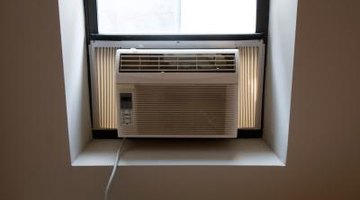115V Vs. 230V Air Conditioner
The larger the room, the more volts your room air conditioner will use and require. This is important to keep in mind when shopping for a room air conditioner. Small units usually require 115 volts, and larger units require 230 volts. A small unit is one you might use for a bedroom, whereas a unit for a basement or garage will normally require 230 volts. Draw a diagram of the outlet, and take it with you when you shop. This will allow to confirm that the air conditioner will work with your existing electrical outlet or that you need an electrician to change your electrical outlets and circuitry.
115-Volt

Air conditioners that operate on 115-volt circuits are usually designed for smaller rooms. As a rule, they will draw on less than 7.5 amps of electricity and can be plugged into a standard 115-volt home outlet. You can determine whether the air conditioner will work in your electric outlet by reading the manual and examining the plug to see whether it will fit with your outlet. A 115-volt electrical plug will have three “male” prongs that protrude from the base to plug into the “female” receptacles on your wall outlet. The plug will have a semicircle-shaped prong at the top, and below that prong to the left and right, the plug will have one wide and flat rectangular prong and one narrow and flat rectangular prong. In most cases, the plug is purposely designed to extend over the top and bottom of the outlet so you are prevented from using the second outlet for any other electrical appliance. This is done as a safety measure to prevent short-circuiting your electric panel and circuit board.
230-Volt
A 230-volt air conditioner is made for larger rooms. It uses more than 7.5 amps and must be plugged into a dedicated outlet. The plug has a semicircle prong at the top and two flat wide prongs. There are two prong configurations for 230-volt air conditioner plugs. In one configuration, one prong is vertical and the other is horizontal.
Similarities
Air conditioners that run on 115 or 230 volts are essentially “plug and play” appliances. The key is to make sure the electric outlets match the voltage and plug configurations. Otherwise, you need to have the outlets reconfigured by an electrician. You should always treat the outlet for an air conditioner as a “dedicated” outlet. Use it for the air conditioner only, even if it is set up to plug in two electrical appliances or devices.
Differences
A 230-volt air conditioner may require an electrical outlet that has a capacity up to 50 amps. This might be the case if you are installing a portable terminal air conditioner or a through-the-wall unit, similar to the types of models you see in hotels. Your owner’s manual specifies what is required for your unit. A 230-volt unit always requires a dedicated outlet, and, in most cases, this means the plug will only have one receptacle. The unit also requires a dedicated circuit on your main electrical circuit panel. While a 115-volt air conditioner may not state that it requires a dedicated circuit, it is a good practice do so as a safety precaution.
References
Writer Bio
Cheryl Munson has been writing since 1990, with experience as a writer and creative director in the advertising industry. She holds a Bachelor of Arts in journalism with a focus on advertising from the University of Wisconsin in Madison.
Photo Credits
- Jupiterimages/Photos.com/Getty Images
More Articles



